Major news media outfits have cut back in the regions in recent years. That doesn't just leave locals worse off - it also means all New Zealanders miss out on important ideas, events and perspectives. But even though the media's margins are tight, intrepid publishers and people are still doing the business there. Mediawatch checks in on Whanganui to find out how their media are doing - and how they're doing it.

Eruera Rerekura with the crew of Awa FM Photo: Supplied
At the front desk of the River City Press in Whanganui, John and Sandra Singleton are lining up to buy ads.
She’s a psychic numerologist. He’s there to drum up interest in his local jazz orchestra.
“With us, you can either come listen to music or have your bumps read, so it’s either/or,” says John.
“I don’t do bumps!” retorts Sandra. “Be careful what you say, my boy.”
The Singletons have their quirks. For one thing, Singleton may not be their real name.
They tell Mediawatch they chose it, perhaps to save people the hassle of memorising a double-barrelled surname. Despite having the same last name, the couple are only just about to get married after 59 years together.
“We’ve just been trying one another,” says John.
If they’ve taken their time committing to their relationship, they’ve had no trouble making a financial commitment to the Press.
They’re both regular advertisers in the free weekly paper - and far from the only ones.
When Mediawatch comes to visit, the paper’s only front page story is wedged between ads for electricians, plumbers, mechanics, vocational training and half-price mattresses.
In an office next to a rusting old bicycle, its sole reporter, the 71-year-old former teacher Doug Davidson, is working on a story about a pair of local musicians.
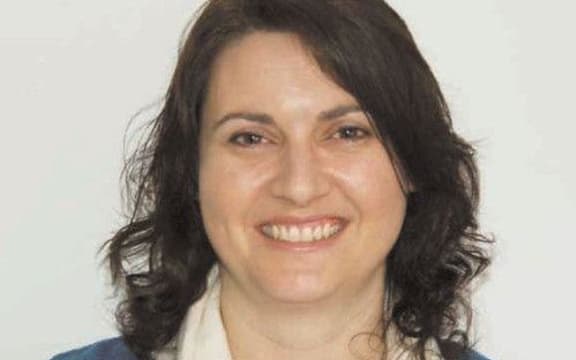
Debbie Jarrett. Photo: The River City Press
His job is the result of a late career change. He’d been teaching for about 20 years when he saw a reporter role at the Press advertised and applied on a whim.
“They considered that an older person might be a better fit for a community newspaper,” he says.
“I think it suits the older clientele, but also after 20 or 30 years in a town you make a lot of contacts, and they can be very important.”
River City’s tagline is “the good news paper” and its owner and publisher Debbie Jarrett attributes its staying power to its positive outlook and community connections.
“It’s just all local news. We focus fully on Whanganui and the surrounding region. We don’t have negative stuff that’s happening around the world. It’s purely what great things are happening in Whanganui,” she says.
“I really feel sorry for people looking from outside of the region. If all they see of Whanganui is from major news outlets, it's probably 90 percent negative. They're just focusing on ram raids, and fraud or stabbings or whatever. There’s so many good people out there doing great things in the city. They’re the ones we should be focusing on and promoting. People want to see what their neighbour’s doing or what happened in their suburb.”
The end of print?
It’s not all good news for the River City Press. Jarrett says she’s had to cut back on staff over the years and can now only sustain six employees.
But the paper still bucks the trend somewhat with its continuity and profits.
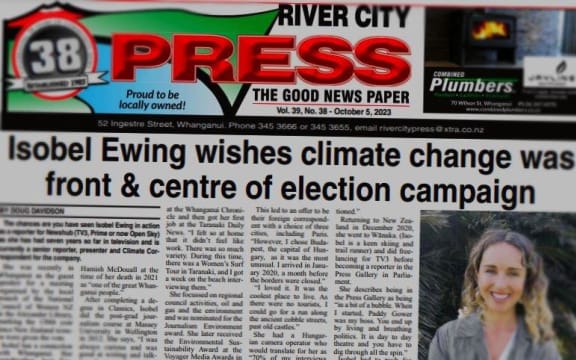
Newshub reporter Isobel Ewing on the front page of The River City Press Photo: The River City Press
Community news outlets across the country are facing staff cutbacks as major media organisations – both public and private – reduce their presence in regional centres.
When TVNZ’s sole Dunedin-based news reporter Maddy Lloyd resigned in April, it was five months before the state-owned enterprise even posted a job ad for her replacement.
Meanwhile commercial organisations including Stuff and NZME have stripped back or sold community papers in what has been described as an effort to “consolidate” their operations.
In an interview with Mediawatch in August, outgoing RNZ head of news Richard Sutherland decried the media’s diminishing focus on the regions.
“As the commercials have retreated to the metropolitan centres they have left – not news deserts – but certainly news savannahs.”
Whanganui has experienced several of its own consolidations over the decades, and some might now deem it a news savannah. A list of newspapers have come and gone in the town, from its first, the Wanganui Record, which was printed on “one side of half a sheet of foolscap”, to the Wanganui Times, and the Wanganui Herald.
Since 1856 though, one outlet has remained - the NZME-owned Whanganui Chronicle which also publishes the weekly community paper Midweek.
Its editor Zaryd Wilson says despite the economic headwinds facing the news media, it’s sticking around.
“We’re definitely safe. The Chronicle will continue to be here for years,” he says.
“We’re still telling stories every day about Whanganui. The way that’s done is changing. It’s changing with the mediums, the format, different levels of resourcing. But it’s still happening and I think it will continue to happen.”
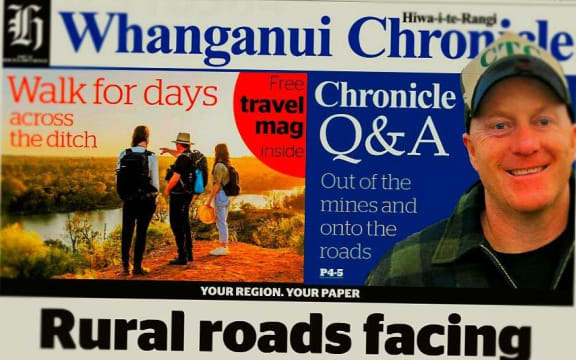
Photo: NZME
Some have speculated those changes might involve discontinuing the print editions of papers like the Chronicle.
Printing costs have spiralled in New Zealand, thanks in part to the closure of the Kawerau paper mill and that’s tightened the economics for newspaper publishers.
Wilson says those challenges are real, but newspapers have survived in the face of financial headwinds for decades.
“People have been saying that for years and we’re still here,” he says.
“I think print will last a lot longer than people think. When I started in journalism they were talking about 2020 as being the end of print.”
His confidence is partly down to the belief that local news fills a niche consumers can’t get anywhere else, especially with major news organisations focused predominantly on – in Sutherland’s words – the metropolitan centres.
It’s not just the papers themselves though. Community reporting also has a way of making journalists like him stick around.
“Once you get entrenched in a town like Whanganui, it is hard to leave. Because you become part of the community, and you know the story of the community, and you become part of telling that story. You know the characters. You know the arc. I don’t have any plans to leave.”
Getting indigenous perspectives on air
Whanganui may not be at risk of losing its local news coverage any time soon, but Wilson concedes the national news agenda is tailored more to Aucklanders and Wellingtonians (like those that staff Mediawatch) than people like him in smaller centres.
That means audiences can miss out on the diverse perspectives that New Zealand has to offer.
For instance the country’s network of iwi radio stations - Te Whakaruruhau o Te Reo Irirangi Māori - is often the only one specifically serving regional Māori audiences.
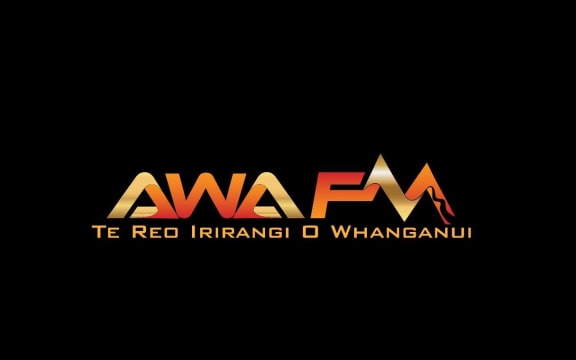
Photo: Awa FM Whanganui
Awa FM is part of that network. It broadcasts on 100FM in Whanganui, 91FM in Ohakune and Raetihi and 93.5FM in Taumarunui.
It’s devoted to broadcasting local Māori language, culture and music while also carrying local news on-air and on its website.
Awa FM board member Nancy Tuaine says the station’s kaupapa is to revitalise te reo Māori and reflect the practice of Whanganuitanga.
“Being Whanganui people. Whanganui River people. Our ability to live alongside our awa,” she says.
Awa FM gets $600,000 a year from the government Māori broadcasting funding agency Te Māngai Paho and that money covers everything – salaries, technology, and all the other costs of running a radio station.
It also employs one reporter – Moana Ellis – through the Local Democracy Reporting service, which was set up in 2018 to arrest the decline in community news reporting and ensure council business and courts are covered in areas where reporters are disappearing.
Tuaine says the station gets by because its staff are willing to sacrifice to make sure it keeps running.
They know the voices and perspectives on Awa FM aren’t going to come from anywhere else.
“I absolutely have seen us bear the brunt of sensationalism. Bear the brunt of the 6pm news or the election campaigns. We are easy pickings because there are so many challenges we have faced as a people and we become the talking point. But is that good journalism or just lazy journalism?” she asks.
“Being able to be Māori, and tell our stories in the way we see them means we can give coverage to people that they aren’t getting from other media outlets. Being Māori, being iwi, and being able to describe our experiences – where we live and its relevance to our lives – is something special, and that forms the cultural authenticity of this country. Without it, we become pretty plain, sterile and boring.”
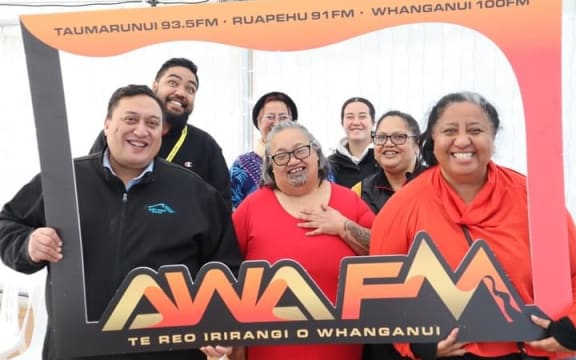
Eruera Rerekura with the crew of Awa FM Photo: Supplied
Tuaine says she can see the impact of outlets like Awa FM in the increased acceptance and use of te reo Māori.
“You know, not too long ago, there was an uproar because the ‘h’ was being recognised in Whanganui. And now it's normalised. So there is an ability for us to play a really positive role within the media to change the way that people practise and behave by just accepting and supporting and uplifting, rather than denigrating and demonising.”
Tuaine doesn’t necessarily think mainstream media outlets have to become Awa FM – her station has a unique purpose and connection to Whanganui.
But – just like Jarrett – she wants journalists, including producers from RNZ’s Mediawatch, to at least spend more time in the area and broaden their horizons.
“I’d say come buy it from us. Come and get your news from us. Because we can give you some top quality perspectives that you don’t get anywhere else,” she says.
Journalists who failed to do that could end up producing limited, one-sided, or shallow reporting, she says.
“They’re not as connected to the people. They’ll be fly-by-nighters. They’ll come in, take their story and go off again. There’s no real attachment to the place in which they’re gathering that story from.”
And with that, I was off.
The cost of not investing in the regions
But before I got in the car, I had one more stop to make, at the 200-metre-long tunnel dug leading to the Durie Hill elevator, where I was due to meet Anthonie Tonnon.
The elevator is a unique public transit service which takes people up and down the steep slope overlooking Whanganui every 5 minutes or so, and Tonnon is its council-appointed operator.
He also has a job as a musician. His album Successor won the Taite Prize in 2022.
Lately that work has increasingly taken a back seat to public transport advocacy.
Running the elevator is just the start. Earlier this year, a new bus service Tonnon designed – Te Ngaru The Tide – was put in place in Whanganui.
Its 20-minute frequency is about six times higher than other bus services in the town, and public transport use in Whanganui has doubled year on year since it was put in place.
The Tide achieved that for a tiny fraction of the cost of a road upgrade or a large public transport infrastructure build in a major centre.
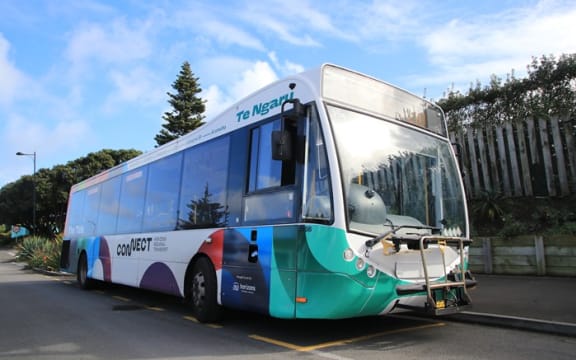
A Te Ngaru The Tide bus. Photo: Horizons Regional Council
Despite that, similar projects got a low billing in the transport debates of our recent general election campaign, which was instead dominated by our major parties’ competing plans for multi-billion dollar transport tunnels and motorway upgrades.
Tonnon says we may have missed a trick focusing on Auckland’s plan for Auckland’s future and Wellington’s tunnel for Wellington’s airport to the exclusion of almost all else, and that may be a result of our media and politicians being clustered in those cities.
“The media doesn't quite have the perspective that Wellington has 70 trips per person per year. Whereas a town like Napier has between five and 10 trips per person per year,” says Tonnon.
“If the people in Wellington were willing to, to throw a few chips the way of Napier Hastings, then they could see a faster increase in public transport use than what they can see in Wellington with a big infrastructure improvement. But you know, people live in the towns they live in and the largest media lives in Wellington and Auckland.”
Tonnon says that bias is understandable to a certain extent. But it means we often miss out on cost-effective, easy ways to improve the lives of many people.
“I guess it's understandable that when you are living and working in Wellington or Auckland, you say ‘how could this be better?’, and then you start thinking about the money that needs to be spent there. I mean, I don't begrudge that at all. I'd love to see us have world class infrastructure and Wellington and Auckland, I'd only say spare a thought for us because with not that much investment, we could see a much greater public transport system.”
That reminder applies to media companies as well – particularly the public ones with a remit to serve all of New Zealand.
Regions like Whanganui are crying out for some chips to be thrown their way.
But that cash doesn’t have to be charity.
Just as John and Sandra Singleton found out with their ads for psychic numerology and weeknight jazz, in places like this, small investments can come with a big return.


